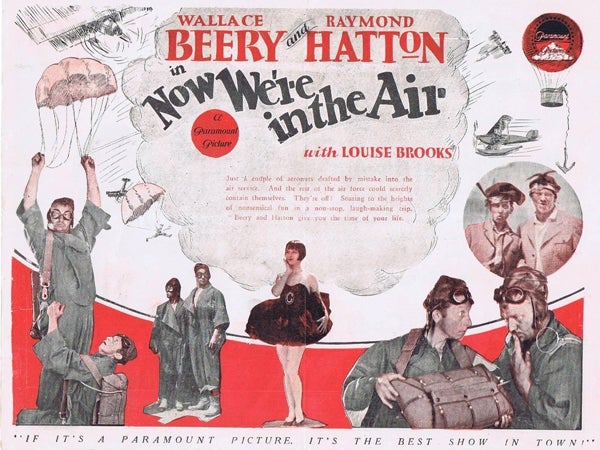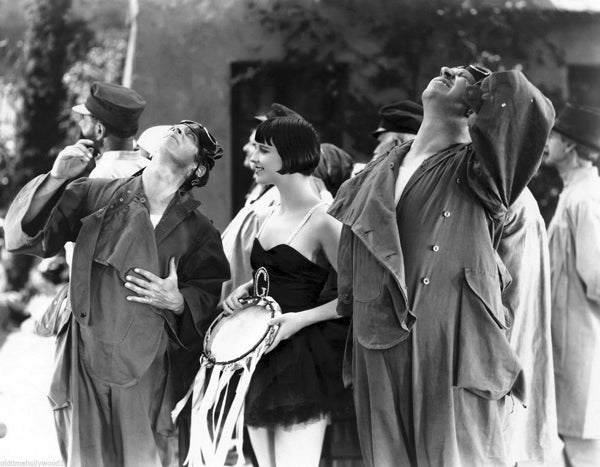Approximately 23 minutes of a long missing 1927 Louise Brooks film, Now We’re in the Air, has been found in an archive in the Czech Republic. The discovery is significant, not only because of Brooks’ widespread popularity, but because it helps fill a gap in the legendary actress’ body of work. Until now, each of the four films Brooks made in 1927—at the peak of her American career—have been considered lost.
The San Francisco Silent Film Festival revealed the existence of the film while announcing the lineup of works to be shown at its upcoming event. The newly restored partial film will be shown at the Festival, which is set to take place June 1 through June 4 at the Castro Theater in San Francisco.
Now We’re in the Air will be paired with Get Your Man (1927), a Dorothy Arzner directed film starring Clara Bow. The Library of Congress has reconstructed Get Your Man from recovered materials, filling in missing sequences with stills and intertitles. Festival Executive Director Stacey Wisnia noted that the pairing brings together not only two recovered films, but also the era’s two “It” girls, Bow and Brooks.
The discovery of Now We’re in the Air came about, in part, through the efforts of film preservationist Robert Byrne, president of the Board of Directors of the San Francisco Silent Film Festival. Byrne has made a name for himself of late, having helped in the recovery and restoration of a handful of important films over the last few years. Prominent among his discoveries were two films identified in the collection of Cinematheque Francaise, Sherlock Holmes (1916), and Silence (1926). The latter, a Cecil B. DeMille production directed by Rupert Julian, will also debut at the June event. Another of Byrne’s efforts, Behind the Door (1919), is due out on DVD / Blu-ray from Flicker Alley.
In a recent interview, Byrne related how he mentioned to English film historian and Academy Award honoree Kevin Brownlow that he would be going to Prague to visit the Czech Národní filmový archiv (the Czech Republic’s National Film Archive). It’s known they have an extensive collection of silent era material, including the only remaining nitrate copies of a number of American silent films. Unsure as to what might be found, Brownlow provided Byrne with a list of about a dozen titles he should ask to see. That list included Now We’re in the Air. Though popular in its time, the 1927 film is little known today except for the fact it includes Brooks in an important supporting role.

When Byrne inspected the elements for Rif a Raf, Piloti (the Czech title for Now We’re in the Air), he found the film had only partially survived in a state which also showed nitrate decomposition. Additionally, the surviving scenes were found to be out of order, and there were Czech-language titles in place of the original American titles. Byrne spent more than eight months reconstructing the surviving material, including restoring the film’s original English-language inter-titles and original tinting.
“As is often the case, the most challenging aspect was not the technical work of cleaning up the image,” Byrne stated, “but rather the research that ensured we were making a faithful restoration, especially when it came to replacing the Czech language inter-titles with the original English versions.”
Byrne was especially appreciative of the help given by the Národní filmový archive. “They were incredibly gracious and generous with their time and resources; in addition to granting access to their nitrate print, they are responsible for the color-dye tinting of our new 35mm print. This is the first San Francisco Silent Film Festival restoration where we have used the traditional dye-tinting process to restore a film’s original color. In prior projects, we have used a modern method that utilizes color film stock.” Byrne added, “This is what an American audience would have seen when the film was released in 1927.”
Byrne said he was “thrilled” to find a missing Brooks film. “The shame is that so many of her American films are lost. Seeing Now We’re in the Air projected for the first time was pretty amazing. I have seen stills of her in the black tutu a million times, but actually seeing the sequence where she is wearing it was like watching a still photograph magically come to life.” Byrne’s excitement for the newly found Brooks’ film was matched by Judy Wyler Sheldon, a longtime Brooks’ fan and the daughter of legendary director William Wyler. Festival Artistic Director Anita Monga was likewise excited, and thought the fragment was “revelatory.”
Directed by Frank Strayer, Now We’re in the Air is a World War One comedy starring future Oscar winner Wallace Beery and the once popular character actor Raymond Hatton. The film, released by Paramount, also features Brooks in two supporting roles. The actress plays twins, one raised French, one raised German, who are the love interest of two goofy fliers. The surviving footage of Brooks only includes her in the role of the French twin, a carnival worker dressed in a short, dark tutu.

Raymond Hatton, Louise Brooks, Wallace Beery
In the 1920s, Beery and Hatton were teamed in a number of popular Dumb and Dumber-like comedies. With its aviation-theme, Now We’re in the Air was one of the pair’s “service comedies,” following similar themed movies like Behind the Front (1926) and We’re in the Navy Now (1926).
Notably, the film’s cinematographer is Harry Perry, who worked on two other significant aviation pictures, Wings (1927), and Hell’s Angels (1930). Perry was nominated for an Academy Award for his work on the latter. Interestingly, a notation in the script for Now We’re in the Air uncovered during its restoration calls for the use of left-over footage from the William Wellman-directed Wings, another WWI movie, and the first film to win an Academy Award for Best Picture. That footage can be seen during the Armistice scene in Now We’re in the Air, near the end of the surviving footage.
Though some winced at its crude humor (not evident in the surviving material), the Beery-Hatton film proved to be one of the more popular comedies of 1927. Generally liked by the critics, the film did big box office where ever it showed. In New York City, it enjoyed an extended run, as it did in San Francisco, where it proved to be one of the year’s biggest hits. At a time when most new releases played only one week, Now We’re in the Air ran for a month in San Francisco, according to local newspaper listings. In Boston, the film also did well, opening simultaneously in five theaters. At the time, the Boston Evening Transcript noted the audience at one screening “was so moved by mirth that they were close to tears.”
The recovery of Now We’re in the Air comes 90 years after its first release, and 100 years after the United States formally entered what became known as the First World War, on April 6, 1917. Though a comedy, Now We’re in the Air was one of a number of silent films from the time—including Behind the Door (1919), The Four Horsemen of the Apocalypse (1921), The Big Parade (1925), What Price Glory? (1926), and Wings (1927), which depict the international conflict.
Byrne and others involved in the restoration of Now We’re in the Air believe the surviving footage lives up to the promise of its original reviews. In June, Festival goers and Louise Brooks fans will have the chance to see for themselves. More about the lineup of films at the San Francisco Silent Film Festival can be found at www.silentfilm.org.
Thomas Gladysz is the Director of the Louise Brooks Society, which he founded in 1995. He has written numerous articles and authored / edited three books on the actress; recently, Gladysz completed two Louise Brooks-related projects, an audio commentary for the forthcoming KINO Lorber DVD / Blu-ray release of Beggars of Life, and a related book, Beggars of Life: A Companion to the 1928 Film.
